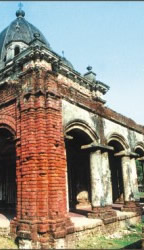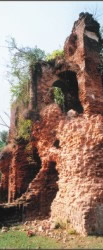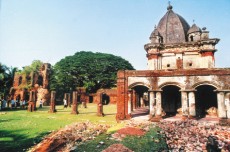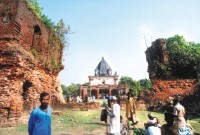The Legendary Baro Bhuiyans of Bengal (12 Chiefs - 16th century)
Bengal was always in political turmoil
The chronicle of Bangladesh starts in 1204 A.D. when a band of several hundred Turkish cavalry had ridden swiftly down the Gangetic plain in the direction of the Bengal delta led by a daring officer name Muhammad Bakhtiyar Khilji. Bakhtiyar was in the service of Muhammad Ghouri, the Sultan of Delhi. He quickly captured the royal city of Nudiya and inaugurated an era lasting over five centuries during which most of Bengal was dominated by the Sultanate. Bakhtiyar’s governorship was a brief one.
Bengal held a special fascination for visitors as throughout the thirteenth century governors of Bengal tried whenever possible to assert their independence from the parent dynasty in Delhi, as Delhi was distant and the temptation to throw off this allegiance proved irresistible. So, governors rebelled and each brief assertion of independence was followed by intervention from Delhi. In 1281 Giasuddin Balban, the powerful sovereign of Delhi, ruthlessly stamped out one revolt by hunting down his rebel governor and publicly executing him. Yet, within a week of Balban’s death in 1287, his own son, Bughra Khan, whom the father had left behind as his new governor, declared his independence.
It is said that the Vedas mention the land of Bengal as Vanga. So we can claim to be a part of an ancient land if nothing else. Many foreign travelers came and went and wrote something or the other about our Bengal.
Everyone mentioned how fertile the land was, how plentiful the fields abound in seasonal crops, how trade between the known world flourished from the seaports of ancient Bengal but nothing good was said about its people. Ibn Batuta’s historical account of Bengal is perhaps the most descriptive, exhaustive. His famous description of Bengal, dozakh puri-e-niamat (hell crammed with [God’s] blessing) is sadly and unfortunately true. So by all accounts, we could conclude that our ancient land was something to be proud of. But what went wrong down the line? What curse befell on us, which god did we infuriate and for what? In spite of all the blessings –– fields filled with paddy, the gossamer muslin, the pink pearls, the spices, Bengal was always in political turmoil.
Rebellious governors, warlords like Isa Khan and his baro bhuiyans, claimants and counter-claimants to the throne of Bengal planted the seed of a destabilised Bengal. Religious differences were taken advantage of by the colonial powers and others whose interest was vested in their own prosperity. The common people were ever so wretched and deprived of dignity and an honourable livelihood…just as they are now.In 1342, a powerful noble, Shams-al-din Ilyas Shah, wrested Bengal free from Delhi’s grip and established the first of several dynasties that remained independent from North India for the next two and half centuries. The Muslim rulers followed a policy of religious tolerance and granted perfect freedom of belief to the people. There is no reference in the chronicles of any of the rulers having ever attempted to impose Islam by force on anyone of the conquered people. There is no evidence of the destruction of any Hindu temples or Buddhist’s monasteries. The Muslim rulers in fact identified themselves with the land, encouraged the cultivation of Bengali language and extended their patronage to both Muslim and Hindu writers and scholars. Although the Sultanate aligned itself ideologically to the Middle East, it was rooted politically in Bengal.
The reigns of Sultan Hussain Shah (1493 - 1519) and his son Nusrat Shah (1519 - 1532) are generally regarded as the Golden Age of Bengal Sultanate. Secure in power, these kings now presented themselves to all Bengalis as indigenous rulers. They had become Bengali kings. The Mughal period in Bengal starts with the overthrow of the last independent Sultan Daud Karani in 1575 by Akbar’s governor Khan Jahan. Soon after the advent of the Mughals there was the rise of an illustrious noble Isa Khan. He virtually ruled Bengal for fifteen years as the Mughal governors failed to subdue him. This period also saw the rise of the twelve Bhuiyans which was a sort of a joint venture among the Bengali and Afghan nobles. In fact I find Isa Khan as one of the most colourful personalities in the history of Bengal. Akbar finally had to send his most powerful General Man Singh to bring Bengal under Mughal rule. To achieve his objective in 1602 Man Singh shifted his capital to what is today Dhaka. The conquest of the Baro Bhuiyans took several years and their resistance led by Musa Khan, son of Isa Khan, is a glorious chapter for the Bengalis.
Towards the end of the 16th century, Protapaditya, a Hindu chieftain and one of the legendary Baro Bhuiyans (literally 12 chiefs, though they actually were 19), became the undisputed overlord of lower Bengal or Bhati, as is mentioned by Abul Fazl in his Ain-i-Akbari. The Baro Bhuiyans, though were nominal vassals of the emperor of Delhi, in reality enjoyed complete autonomy in the south and the southeast of the Gangetic delta.
The troops of the Mughal emperor, Akbar the Great, then were perpetually engaged either in campaigns against or in squashing revolts of turbulent Afghans, who had established themselves as the masters of Orissa and a part of Bengal, even after the death of Afghan ruler of Bengal Daud Karrani. Taking advantage of the situation, the Bhuiyans dug in their swampy retreats, paid little or no tributes to the Mughals and showed of royal pomp, just short of declaring themselves independent kings, with but one exception -- Protapaditya. Protap declared independence and with the help of Pathan Bhuiyans successfully parried a Mughal military clampdown. Apprehending follow-up attacks, by land, Protap moved his capital from Garh-Mukundapur to the water-locked Dhumghat. There he raised a formidable naval force recruiting.
Portuguese sailors and Arakanese pirates in his fleets. Through a series of conquests in the next few years, he continued expanding his kingdom until the neighbouring polities accepted his superiority. Protap as an individual was a devoted Hindu but practised secularism in matters of governance. He commissioned Pathan and Seljuk Turks to command his army. Besides temples and mosques, he also permitted Jesuit missionaries to erect the first Christian church in Bengal in 1598.
Goddess Kali
Legend has it that Protap's most trusted general was Kamal Khowaja, a Seljuk Turk fortune-hunting mercenary soldier, whom the king entrusted with safeguarding his Dhumghat palace. One night during a round of inspection of the palace guards, Kamal saw an unusual glow near the horizon in the pitch-black sky. Taking it to be a supernatural phenomenon, the Turk hurried to the king's bedchamber, woke and told him about the vision. Protap immediately came out to see and did see the strange illumination. He reckoned that the source of the light was in a dense forest some 20 kilometres west of the palace. The very next day he went to that place with a company of soldiers. They felled the trees and cleared the spot, and then excavated it to unearth a huge head of a touchstone statue of goddess Kali.
Jessoreswari
Protap forthwith declared the idol the guardian deity of his kingdom and named her Jessoreswari. He built a temple complex for the goddess, which came to be known as Jessoreswari Temple and the area as Ishwaripur. The king vested a large area of land in the temple complex for its maintenance and to bear other expenditures including regular worship. Over the time, King Protapaditya turned into a bloodthirsty tyrant and killed some of his close aides, uncle Raja Vasanta Roy and his sons, and to please the Arakanese pirate chief he treacherously killed the Portuguese commander of Sandwip by inviting him to his Dhumghat palace. He also the drove out Jesuit priests.
Then a gust of wind changed his fate. A strong Mughal battalion under the command of Enayet Khan marched against Protap. He was taken prisoner and his capital captured bringing an end to the Protap era. In course of time, most of the monuments built by Protapaditya went to rack and ruin. But the temple complex of Iswaripur is still there to herald his name and fame. The two-storied temple building underwent renovation on several occasions, extensively after the most damaging cyclone of 1864. For that reason it is now difficult to read the actual style of architecture it inherits. In 1971, the Sebait (the chief priest of the temple) removed the original idol of Jessoreswari to the Indian sub-division of Bashirhat never to return it back to the temple. However, there is a replica of the deity there. Although on the wane, the heavy high walls of the complex still speak of the temple's pre-Mughal origin with all its glamour and glory (K. Chowdhury, August 2005).




